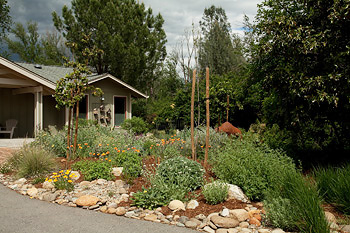| |
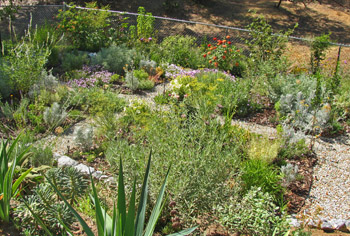
Summer heat in Victoria Garden Is saving water in Redding gardens possible?
Like so many new Redding residents I got the shock of my life during my first summer months in this area. Till you experience it yourself, you can’t believe how temperatures in the triple digits may feel like. I can tell you now. It feels like living in a hot blistering furnace. People and native plants wisely adjust in order to survive, but what about garden plants?
I must admit, in the Netherlands, I was never a fan of rainy summers or the big thunderstorms producing pouring rain that mark the end of a short heat wave, but at least we never had to cope with months without a drop of rain and hardly ever had to water the garden.
Hose ban.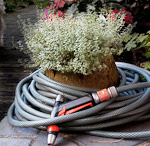
The closest experience I had to watering the garden was in England. I lived for four years in the South of England and you wouldn’t believe it, nearly every summer, a short ‘heat wave’ occurrs. Of course Redding residents will laugh; we are talking about temperatures in the high eighties and maybe a few weeks without rain. Sadly in England the predominant chalk rocks drain the water quickly and so the famous lush British gardens suffer badly.
Like in Redding, watering the garden is then a necessity, but worse, like in Redding in 2009, water is sometimes restricted due to a shortage. A typical British measurement deals with these problems: a hose ban. You may use water for bathing, and open every water tap, but you are not allowed to connect a hose to the tap. Keen gardeners hover around with water cans to water their most precious plants, but the famous British green gardens suffer and the lawns turn yellow.
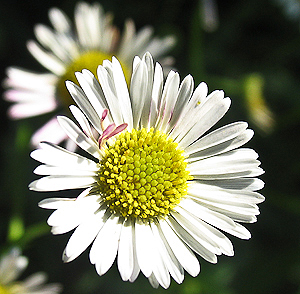
Erigeron karvinskianus, Santa Barbara
Daisy
in Victoria Garden.
Choose your plants.
The British lawns normally recover quickly when the heat wave is over. On the other hand, here in Redding, the ‘heat wave’ is unfortunately a very reliable fact and lasts always for months. In recent years we also learned that our water supply isn’t endless and some parts of Redding the water supply was already restricted. Is it then advisable to have these ‘British lawns’ here in Redding when, even in England, they need more water than the clouds supply?
Natives.
Ever thought of using native plants, like Santa Barbara Daisy, Common Yarrow, low growing Manzanitas, or native grasses like deer grass instead of the traditional lawn?
These low growing plants need only a fraction of the water that the normal lawns. They don’t need to be mowed every week and most have the beautiful flowers. Maybe they don't look as tidy as the common green carpets, but isn’t it time to invent a new local tradition instead of imitating those of a country, our ancestors left already ages ago? Chosing plants adapted to our local climate?
Drought tolerant plants.
Not only the lawn but the whole garden can be planted with drought tolerant plants. All kind of plants originating from places all over the world (as long as they have a long hot and dry summer) will feel at home in the unforgiving Redding summers.
Unfortunately not all Mediterranean plants appreciate our winters. Not every part of Redding is frost free in winter. Most Garden books tell us that Redding falls in garden zone 9, but especially outside Redding, like in my garden in the foothills just west of Redding, one can experience night frost as low as 28 degrees and many drought tolerant plants (natives and other Mediterranean plants alike) are not that frost hardy. Besides that, every 10 years it is even colder and another set of plants won’t sprout out after the winter. I found out that my garden can be best classified as zone 9 in summer, but if I play it safe, zone 7 in winter.
So if you don’t want to replant your garden every year (can also be some fun!) it pays to do some homework. Buy plants that survive summers as well as winters. At Turtle Bay Nursery, Don Brand is the man to answer all your plant questions (a good reason to do voluntary work in the arboretum!) and in most other Redding nurseries they will tell you exactly how frost-hardy a plant really is. With a bit trial and error you know which plants will do best in your garden.
On this site I made a list from drought tolerant plants I grow in my garden. You also can get great ideas from the photos of Leslie’s garden, the Matson-Mowder-Howe Celebration Garden and the Stoker garden. These wonderful gardens, contain exclusively drought tolerant plants and need hardly watering!
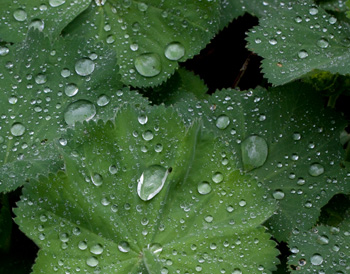
Waterdrips on Alchemilla mollis (Ladies Mantle) in
Victoria Garden Can I also save water with plants that need regular water?
I am a plant nut. I like all kind of plants and I must admit that I also planted plants that need regularly water in my garden. But in order to save water I matched plants together in one border according to their water needs.
Another trick is, placing more water loving plants at the bottom of a slope or near the seasonal creek, or in an area where the soil has higher clay content and can retain water better . Plants also need less water, if they are growing in afternoon shade. You see, even if you grow more water loving plants, there are many ways to save water.
How often do you have to water?
Drought tolerant is a very flexible term. A few drought tolerant plants can survive with no summer water at all, like some native grasses. Others prefer to get some irregular deep watering, only in the dry months. Another set of plants will be pleased if presented with regular watering, even daily, depending on your soil. Many garden books and plant labels will tell you exactly how much water a plant needs.
If the plants are matched together according to their water needs, some ‘indicator plants’ can tell you when it is time to water. These plants will wilt immediately if the soil is too dry. You also can just poke your finger deep in the soil. Who says that you must have green fingers to garden? Mine are always brown and dirty! If the soil is deeply bone dry, you know the garden needs more water. Just walk around on a daily basis. Enjoy your plants and at the same time you will notice if they are happy and can regulate the watering system accordingly.
Influence of soil type on watering.
On the valley floor, where the soil contains a high quantity of clay, watering can be less frequent. Some gardening friends are proud owners of a gardens that need no water at all, or only once a week or whenever they feel like it. Less frequent watering is better. It will encourage plants to develop deep roots, so they can longer provide themselves with water and food.
On the other side, sometimes you can’t prevent frequent watering. My garden, in the foothills is mostly based on granite and the soil doesn’t contain so much clay. Combined with the fact that I recently created borders, and mixed lots of compost through my original poor soil, water will immediately drain away and unlike the valley floor gardens, the borders are dry within no time. For that reason some parts of my garden still need every day watering. Having said that, compared to gardens with a large traditional lawn, my garden still only needs alltogether a fraction of water.
Last, but not least, whatever plants you choose, whatever your soil condition, the first summers all plants need some summer water and slowly they can be weaned off in the following years.
Mulching.
Another way of saving water is mulching. A thick layer of bark (preferable two inches) on your borders between the plants can prevent water evaporation, and at the same time cools the roots of the plants.
I use compost on some borders, bought from the City of Redding as mulch. It contains hardly any unwanted seeds and stays so smooth that it can be weeded in no time. In fall I work it through the soil and then it acts as a fertilizer. There is on big draw back on using compost. The first year it often doesn’t take up water easily and the plants don’t get the amount of water they need. So I now only use compost that is at least one year old, after storing it a year long on my property. But it is worth the trouble; not only is weeding no problem anymore, at the same time annual garden plants can reseed themselves easily in a ready compost bed.
Saving water by choosing your watering system.
You can certainly save a lot of water by choosing your watering system wisely. The big lawn sprinklers lose a lot of water by evaporation and water running off.
A mini drip system or using soaker hoses brings the water immediately where it should be, at the roots of the plants. Be aware, there is one disadvantage. Drips can clutter up quickly, stop dripping and if you don’t check regularly, plants will die before you noticed it.
A mini spray system sprays at a lower speed and closer to the soil. It allows some evaporation, but blockage problems are noticed easily. It also can water a slightly bigger area around the plants than soaker hoses and some plants prefer that. In addition it makes reseeding around the anual plants more likely.
There are many different mini sprayers: full circle, half circle, ¼ circle, rectangle etc. and if you adjust the strength of the spray, you can water exactly the area around the plants as needed, instead of sprinkling just the whole garden. If you want to know more about watering systems, follow the watering system classes given by Jim Bailey, at Turtle Bay. He will explain what to chose and how to set the system up. It isn't difficult and I saved nearly 70% water by exchanging big sprayer heads to to a combination of drips, mini soaker hoses and mini spray system. If you want, you may visit my garden and I will show you. Please mail in advance.
Conclusion.
You may think after reading: Too complicated, too much work, maybe we should keep one British garden tradition alive. Start slowly with a small border next to your house and year by year, if you feel like it, extend your garden. In this way it is more fun, less expensive and you learn from your 'mistakes'. Enjoy gardening!
Barbara Kapsenberg
These are my experiences. Maybe you have other experiences or other ideas to save water. I would be most thankful if you would like to take the effort to add your story or remarks. Please be welcome to use the comment form or mail your comments to me directly and I will place them here.
TO GET TO THE FORM FOR LEAVING A COMMENT CLICK HERE.
Here are your comments: (I would recommend to read them, because they all give some very useful information about water saving! These are tips from real experienced Redding gardeners!)
| 08-16-2010 |
Mike and Ann
(West of Redding) |
Watering: We use drips and micro-sprayers, for the most part. Some emitters are adjustable for water flow. Everything is on timers and it goes off @ 5:30 a.m., coolest part of the day.
Mulching: We mulch with straw as well as compost; Mike has a mulching machine - he grinds up leaves and garden stuff/clippings etc. We do have a compost bin for kitchen scraps and other organic matter, and we use that for mulching as well.
|
| 08-16-2010 |
Nancy
(Lakehead area)
|
Watering: My garden survives our triple-digit summer days with a combination of a timed water system using low-volume sprayers and drip emitters. These do need regular checking as seeds and bugs often plug them. A fast squirt from our air compressor fixes the problem and I'm back in business.
Mulching: Pine-needle mulch as a blanket each winter provides frost protection, and as it breaks down, a great mulch for holding moisture in the summer. And, on the mountain, it's plentiful! |
| 08-16-2010 |
Carole (West of Redding)
|
How often do you have to water: I've found in general that people water too much in Redding. Even with our heat, I only water my vegetable gardens twice a week and my tomatoes about every 7-10 days depending upon temperatures. Deep watering encourages deep roots and heavy mulching slows down evaporation. Many of the questions I've gotten in the Master Gardener booth (at the Farmer's Market) are from people asking why they are not getting vegetables and most of the problems are from overwatering.
Mulching: I am also a big advocate of using cardboard and/or newspaper for mulching. In the fall I put down cardboard and/or newspaper with a layer of compost on top to keep out winter weeds. In the spring, I either dig holes or scratch out rows for my crops and then put down more cardboard and/or newspaper with more mulch and straw on top. I have no weeds using this method and it cuts down on watering. I use heavy mulch (either compost and/or tiny wood chips) in my flower beds and replenish every year. I don't like to weed and I do like to conserve water. |
| 08-23-2010 |
Carol
(West or
Redding) |
Watering. I live on a hill of rocks and decomposed granite. Over 25 years, I've added much to the "soil" to attempt to retain moisture. I use mostly drip and low-volume sprayers and some raised sprinkler heads that water a large area.
Mulching. I flag down and/or call the tree trimming companies and have them dump their chips in my back yard. I keep 2-3 inches on most of my beds. My roses are on a steep hill so I make rings from vinyl lawn edging and make the rose basin level and have a Dial-a-flow watering head in each one that I can easily see. I keep chips inside and out of the rings. Watering inside the ring generally eliminates weeds in between the roses.
When on a Trip.
An electric auto clock timer is worth the money. It does need to be adjusted during the water season. I eliminate hand watering as we are RVers and are away much of the time. So, pretend you are going on a long trip and set up all your pots and beds on the drip and auto water. Saves you much time and water though I enjoy hand watering but just don't have the time. |
| |
|
|
|
|





